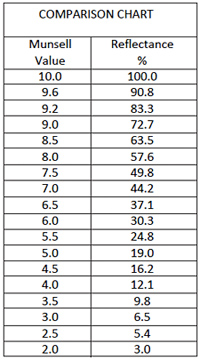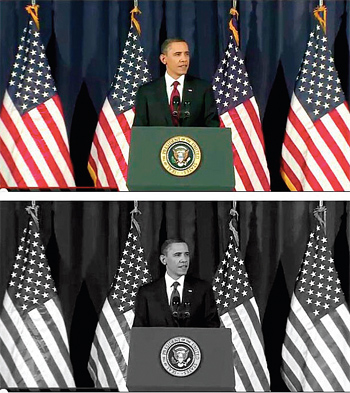Dynamic Range Isn't Infinite
This article was written during the Independence Day holiday. The fireworks were great, but in the back of my mind was the annoying thought that one of the symbols of this celebration offers a perfect example of the cruel realities of lighting for camera.
The reality is that the range of brightness of many subjects is greater than the camera or display system can actually accommodate. In fact, a major part of our job as lighting craftsmen seems to be a constant battle to fit a wide range of brightness into a camera's limited range.
In many cases, the camera will exaggerate these differences in an unbecoming manner, and elements of our picture that we would prefer to play a more subordinate role become dominant. Our nation's flag, so prominent during the Fourth of July activities, is the perfect symbol of this dilemma.
BROAD STRIPES AND BRIGHT STARS
The distinctive red, white and blue of the U.S. flag are very clearly defined. Conveniently, we can define these colors using the Munsell Color System. Although the Munsell system cannot represent the millions of colors in the visible spectrum, it can come very close. More importantly, its manner of representation is very useful in association with the camera's color reproduction process.

Fig. 1: Comparison between Munsell value and reflectance The system organizes color by means of a series of hues, ten in the most common form. These are named in a very familiar manner as Red, Yellow, Green, Blue, Purple and then the "compound" hues as Yellow-Red, Green-Yellow, Blue-Green, Purple-Blue, and Red-Blue. They are usually arranged in the same order as the spectrum of visible colors. The idea is that a color surface has three qualities: Hue, Chroma and Value. Hue is a name for a group of colors.
The idea of Chroma may be initially puzzling. Chroma is the amount of color. It is described as the degree of color saturation or "purity." A pastel will have less purity than a heavy solid color of the same hue.
Value, which is of most interest to us, is a number from 0 to 10 that is assigned to a sample and represents the "lightness" of the object—in other words, its brightness after you remove the Chroma.
We can now compare a sample's reflectance if we have its Munsell designation. Fig. 1 shows the reflectance corresponding to Munsell Values. Note that the commonly accepted reflectance of 18 percent, mid-scale for exposure of typical subjects, is about a Munsell value of 5.0.
GETTING THE REFLECTANCE
The red of the flag in Munsell notation is 5R 4/14. 5R refers to a medium red hue whose chroma amount in Munsell notation is 14. The Value is 4. Referring to Fig. 1, this corresponds to a reflectance of 12 percent. The flag's blue is 5PB 1/4, a Purple–Blue with a low amount of chroma (1) and a value of (4) corresponding to a low reflectance of 1.5 percent.
The stars and stripes white is as white as possible and we will arbitrarily place its reflectance at 90 percent. We are always told that 100 percent is unrealizable. We also are told that the whiteness of Magnesium Oxide, the laxative of choice of our grandfathers, is as close as nature can provide to 100 percent reflectance. I think we can leave the issue there.
THE ROCKET'S RED GLARE
We can now anticipate what we will discover when we put the flag on camera. In Fig. 2, the photo, a screen capture of a speech by President Obama should illustrate this.
The president is at a podium with an array of flags as his background. You can see that the flags are receiving approximately the same amount of illumination as the president; they are practically in the same plane as he is.

Fig. 2: Top: Screen capture of original. Bottom: Color removed to compare reflectance. Here is what you should notice. The white stripes, due to their nearly 100-percent reflectance, have become the most obvious (nearly overwhelming) elements in the picture because of their brightness. Because of this, the main subject, the president, has less emphasis visually. Removing the color results in the second photo where we now can see the reflectivity of the flag as well as the rest of the photo's elements.
In both photos, the red seems to take a proper position in the scale of things. Although it shows less reflectance than the president's face, it is still not too reduced in importance. We see it as red. Recall that its reflectance was just below mid-range at 12 percent.
The blue is another matter. It is not what we expect. It is not the vibrant blue that we envision in our imagination. Instead it appears, due to its low chroma and reflectance, quite lifeless with little hint of color. In fact it is nearly black.
Contributing to this loss of personality also is the fact that the blue field's low value and low chroma places it at the end of the transfer characteristic, which can be quite indefinite and unpredictable. The more stable mid-range part of this function is more forgiving.
PROOF THROUGH THE NIGHT
This is the moment that we must stop looking at the fireworks and assess how to satisfactorily reproduce the flag in our camera system. Unfortunately, we know the pitfalls. If we put equal light on the flag and our major subject, the white stripes are going to take over and the blue field of the flag will barely make it.
We can cheat slightly by changing the camera's transfer characteristic, stretching the blacks to increase the visibility of the blue. This may distort the mid-values too much by raising the average brightness. A second alternative would be to drop the lighting level on the flag to lower the intensity of the white stripes. Under this situation, the red stripes will be okay, but the blue field will literally go to black. We have correctly positioned the flag relative to our subject's brightness but, in doing so, removed the blue field.
GALLANTLY STREAMING
So there you have it. An irresistible force meets an immovable object. Again, the dilemma is best solved by personal judgment by choosing the least objectionable path. (In the case of the flag, there is no way that the colors will ever be changed.)
For the President's speech, the solution was very direct. The flags are placed just barely in frame of the close-up. The flags still dominate the wide shot, a holiday celebration.
Bill Klages would like to extend an invitation to all the lighting people out there to give him your thoughts at billklages@roadrunner.com.
The professional video industry's #1 source for news, trends and product and tech information. Sign up below.
